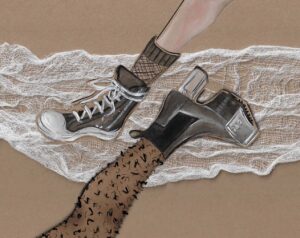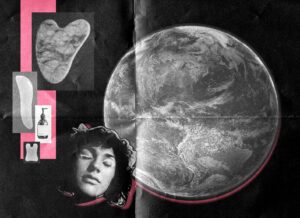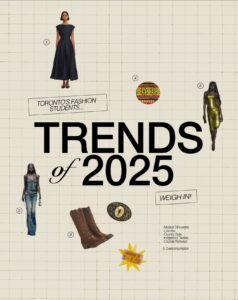Copy editors: Samira Balsara, Eishvinder Gill
Photo: Taken by Imani Busby
Presented by The Image Centre Student Gallery at Toronto Metropolitan University (TMU) from January 25th to February 25th, 2023, “Better City, Better Life” is a powerful exhibit by Chinese artist, Xin He. Xin He is a contemporary photographer that specializes in photographing urban sites.
My first thought entering this exhibit was that the space felt small. The dimly lit, 18 by 24 foot gallery space exhibited photography hung using fabric pins accompanied by a small screen showing a video. The exhibit’s presentation and space gave the impression that it was possibly a precursor to the larger exhibits in the gallery. However, I would argue that this exhibit was one of the most immediately resonant exhibits that I’ve seen in Toronto over the past few months as it contributed to pressing dialogues in the city’s socio-economic spheres. Through stoic black and white images, a collage of destruction, and a haunting demolition video, this exhibit touched on themes of urban development, gentrification, human displacement, and the constant devaluation of people in order to increase state profit.
Excluded from the exhibition’s catalog, a large map was installed on the wall barring a visitor from directly entering the space. The curatorial statement installed below the map, written in both English and Chinese, shared that this exhibit documented changes along Shanghai’s Huangpu River between 2005 to 2009. During this time period, the city was preparing for the 2010 World Expo, an event that promised to bring China an influx in international tourism and an increase in economic, cultural, and scientific advancements. As shared by Dekini, a gallery assistant at the Image Centre, this map portrays the expo and the economic development of the city.

The exhibit itself was divided into three main parts that I will describe as: “Photography of the Past”, “Evidence of the Demolition”, and “The Stark Contrast of the City Today”. “Photography of the Past ” included four black and white, landscape images of Shanghai shot in 2008. “Evidence of the Demolition ” was featured on two parallel walls. One wall held an hour-long video of the Expo demolitions while the other held 30 inkjet print photographs of wreckage from the demolition (2010). Lastly, “The Stark Contrast of the City Today” featured four striking inkjet color photographs. These images portrayed He’s friend holding a framed photograph from the 2008 collection and standing in front of the new development.
The evolution portrayed in these images made me wonder what progress really means in an urban space. Are cities truly taking steps forward when they occur at the expense of their citizens? What happened to these families when their homes became unlivable? Did they benefit from the economic development or were they the casualties? What would happen if we drew connections between state-mandated evacuations and economic evictions to the rise in homelessness?


Before you leave the exhibit, the viewer is made to confront the map again. Seeing it the second time felt ominous. It looked too colourful, felt too cheerful, and now resembled a map of a summer fair or amusement park. It felt out of place. It felt like a cover-up. It felt like a politician saying that they were working on developing solutions to a problem they created. It felt like a smiley face sticker on a gaping sinkhole.
This exhibit made me wonder what Toronto’s version of this exhibit would look like. The city is continually demolishing significant and historic buildings. It has gentrified its culturally diverse neighborhoods and erased their signature identities. The city has raised its cost of living, thus displacing thousands of families and individuals. Where do our displaced people go? Do we have sustainable support systems for them or are they also just casualties in the hope of economic advancement? If we compiled our photographs documenting the displacement of our families and communities, would we deepen the pool of grace, compassion, and support for the city’s unhoused communities? Would they still be dehumanized and brutalized? The city of Toronto is no different to Shanghai and is, in many ways, deeply on the same path. My only question is, when and where will we draw the line?


























